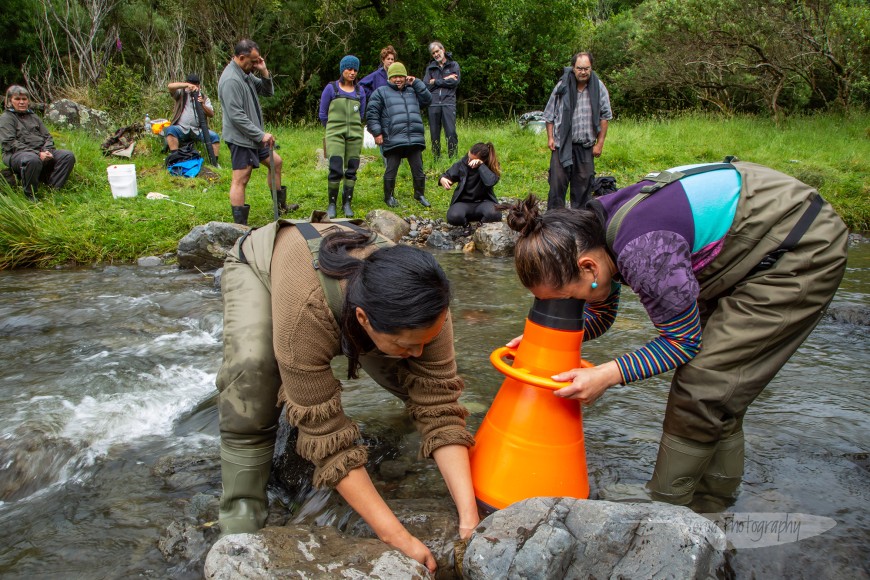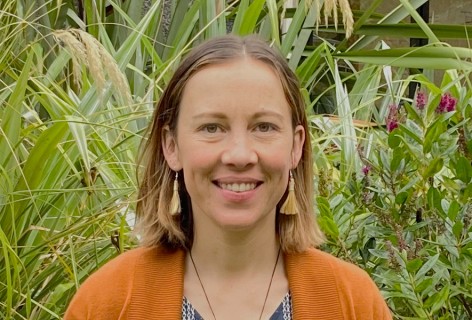This is an example of a cultural indicator – a tohu – as part of a wider cultural monitoring system – an intergenerational knowledge approach, based on Māori values, used by mana whenua and deeply rooted in te ao Māori ways of thinking and interacting with the natural world (taiao).
In a recent paper on decolonising cultural environmental monitoring in Aotearoa New Zealand, Manaaki Whenua toi rangahau Māori Garth Harmsworth and his colleagues argue that while cultural monitoring is increasingly prominent in environmental policy and reporting, there is a need to proceed with caution about how institutionalisation of Māori approaches can reduce its integrity, value and meaning.

Kairangahau Māori Jade Hyslop and Manaaki Whenua researchers take part in a Rangitāne iwi/hapū cultural monitoring wānanga on the Manawatū River.
Photo credit: Toroa Creative.
Use of cultural environmental monitoring
Central and Local Government authorities are required through environmental legislation and policy to engage proactively and meaningfully with Māori.
“This has put Māori researchers and practitioners at the forefront, with the creation of methods such as the Cultural Health Index (CHI) and mauri compass, where mātauranga Māori (Māori knowledge) is increasingly used to inform many aspects of environmental assessmwent, decision-making and reporting,” says Garth.
To date most investment in cultural monitoring has focused on freshwater. However, approaches have also been developed for the marine environment (moana, takutai), forests (ngahere), soils (oneone) and land (whenua).
Of Aotearoa’s 16 regional councils, 12 reported using CHI in their regions, 11 reported using cultural mapping, over half reported cultural monitoring of taonga (treasured) species and every region reported use of at least one cultural monitoring framework.
The challenges
Garth is part of a core group of Māori researchers (kairangahau) who work across Aotearoa to develop cultural monitoring that enables local groups such as whānau, hapū, and kaitiaki to clarify their values and priorities and undertake environmental monitoring and reporting.
“While it is important to include cultural monitoring requirements in policy and planning, there needs to be equal importance placed on ensuring we have the enablers to tautoko (support) Māori at the grassroots level,” says Garth.
With widespread use of cultural environmental monitoring, Garth points to several challenges that risk jeopardising these kaupapa Māori approaches.
There is a risk that Government agencies will ‘cherry pick’ Māori data outputs to match their formatting and evidence-based requirements.
In the paper, a Māori researcher describes that councils that are now monitoring native fish, for example, sometimes think “right, I’ve done all my cultural indicators and now I can comment on tuna [eel] health” without considering the broader holistic te ao Māori knowledge base.”
The paper comments: “What happens is that those beautiful concepts get put into policy, and then it’s up to interpretation, most of the time by non-Māori to actually apply it into strategy or action.”
“The next steps in the national Māori environmental performance indicators work will be telling: will the state try to fit cultural monitoring into a small box, or will they try to incorporate the wider plethora of socio-cultural and socio-ecological indicators recommended as more consistent with te ao Māori?”
Garth says at its essence, decolonising cultural monitoring requires listening to Indigenous voices and concerns, and placing these at the heart of cultural monitoring, locally and nationally.

